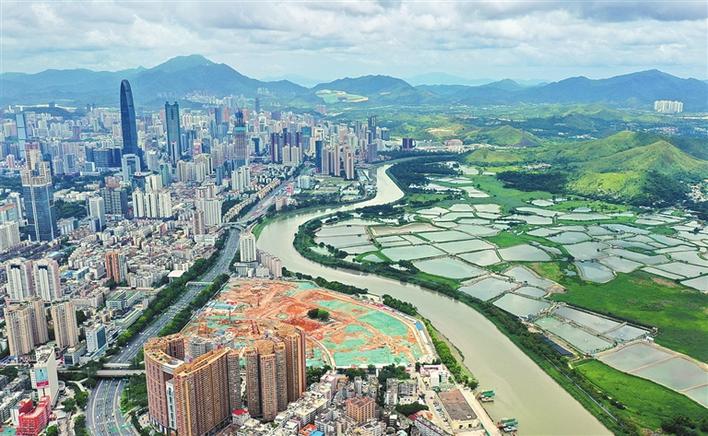
An aerial view of part of the Hetao Shenzhen-Hong Kong Science and Technology Innovation Cooperation Zone on June 22. Sun Yuchen
The Hetao Shenzhen-Hong Kong Science and Technology Innovation Cooperation Zone, straddling the boundary between Shenzhen and Hong Kong, has been witnessing plenty of innovation and entrepreneurship stories.
On the northern bank of the Shenzhen River, the cooperation zone’s Shenzhen portion has become a place where opportunities abound for young Hong Kong people who regard it as a prime platform for innovation, creativity and entrepreneurship.
The cooperation zone is comprised of two portions, the 3.02-square-kilometer Shenzhen portion which includes the Huanggang Checkpoint and the Futian Bonded Zone areas, and the 0.87-square-kilometer Hong Kong-Shenzhen Innovation and Technology Park.
In order to attract talent and enterprises to develop in the cooperation zone, the governments of Shenzhen and Hong Kong have jointly launched a policy package to implement measures conducive to the flow of talent, scientific research resources and business development.
As the only special platform featuring science and technology innovation in the Guangdong-Hong Kong-Macao Greater Bay Area (GBA), the cooperation zone possesses distinctive advantages in terms of strategic location, institutional advantage and spatial layout.
Sing Chan, a Hong Kong entrepreneur, founded Unispace, a youth entrepreneurship space, in the Shenzhen portion of the cooperation zone in 2020. The space has so far introduced about 50 Hong Kong startup teams, providing incubation services for young Hong Kong people who want to start businesses in the city.
As a member of the first batch of Hong Kong youths who started a business in Qianhai, Chan has seized opportunities to carve out his own career in Shenzhen.
Knowing the difficulties young entrepreneurs face, Chan began to think about how to optimize entrepreneurial services and provide support for more young people from Hong Kong to start businesses in the GBA and build a bridge between them and the mainland.
Since 2016, Chan has participated in the construction of multiple youth entrepreneurship bases and helped over 300 Hong Kong startup teams to develop in Shenzhen.
Chan was optimistic about the cooperation zone’s prospects and hoped to replicate or upgrade the entrepreneurship experience he gained in Qianhai and apply the experience in the Shenzhen-Hong Kong cooperation zone.
“The cooperation zone featuring tech-driven innovation is very suitable for Hong Kong youths to start businesses. The zone is also close to checkpoints, which greatly facilitates people’s travel,” Chan told Shenzhen Daily.
“I’ve been in the cooperation zone for almost two years. I can see that more and more technology firms are gathering here, which offers access to many different technologies. There are not only engineers from the mainland but also scientists from Hong Kong, which easily encourages cooperation,” Chan explained.
According to Chan, the policy packages the city government offers are diversified and elaborate, which are aimed at creating favorable conditions for Hong Kong and Macao youths to start businesses in Shenzhen.
As a “super liaison” for Hong Kong startup teams, Chan hopes he can contribute more to help Hong Kong firms develop on the mainland, enjoy the dividends of national policies and the market, and accomplish personal dreams.
Shenzhen NED Optics Co. Ltd., located in the cooperation zone, is a national high-tech firm focusing on smart headgear for augmented reality, virtual reality and mixed reality.
The company’s CEO and founder Peng Huajun received his Ph.D. in flat panel display and optoelectronics at the Hong Kong University of Science and Technology.
“The cooperation zone provides a broad platform for Hong Kong entrepreneurs. It is not only open to the GBA, but also the whole country and even the whole world,” Peng said in a previous interview.
So far, the cooperation zone’s Shenzhen portion has introduced 10 high-quality scientific research projects from five Hong Kong universities as well as various types of scientific research institutes and innovative enterprises, and a whole innovation ecosystem is in the making.



